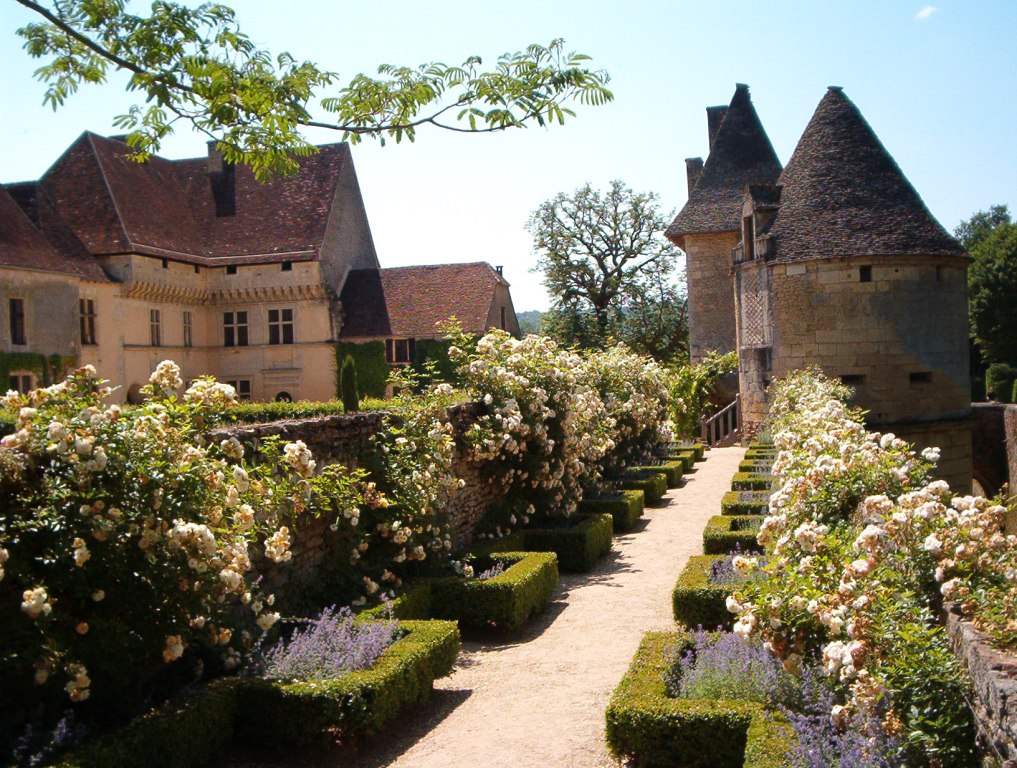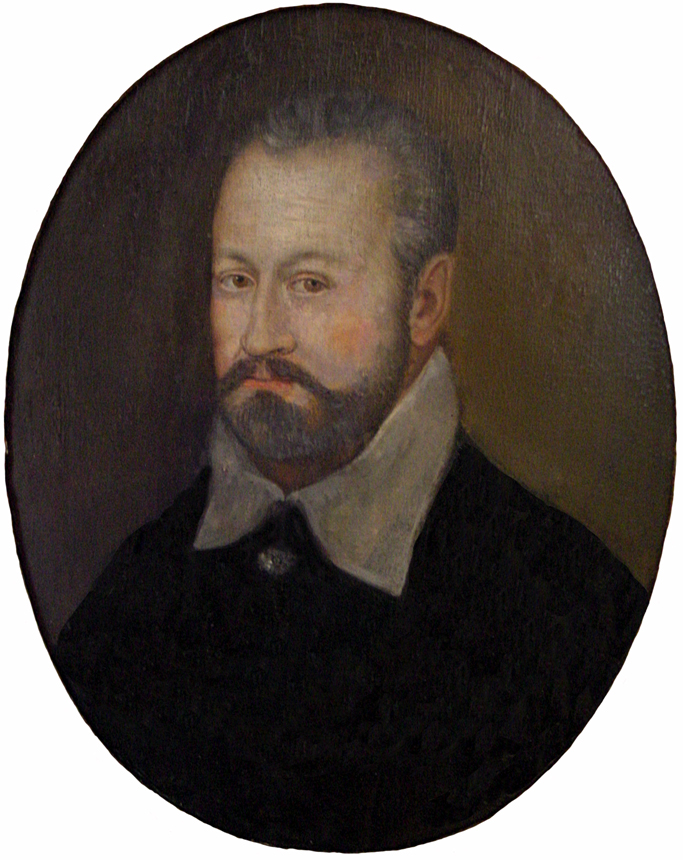|
Château De Losse
The Château de Losse and its gardens have been listed as French Historical House and Site since 1928. They are located in Périgord, Dordogne district, South-West of France, near the Lascaux pre-historic caves, on the Vézère river. The medieval fortress overlooks the Vézère river. In 1575, a Renaissance Hall was built within the stronghold. It is enclosed by curtain walls and surrounded by a deep ditch. Inside the décor and the period furnishings bear witness to the grand lifestyle of the Marquess Jean II de Losse in the 16th century. History The Losse family came from Flanders in the 11th century and subsequently built a stronghold on the right bank of the Vézère . From that time they belonged to the feudal hierarchy. Later on their allegiance went to the king of France. The Hall was built in 1576 inside the medieval fortress by Jean II Marquis de Losse. A great soldier, his loyalty to the Crown was the source of his military and social good fortune. He was page to F ... [...More Info...] [...Related Items...] OR: [Wikipedia] [Google] [Baidu] |
Losse03
Losse may refer to: People * Losse (surname) Places * Losse, Saxony-Anhalt, a municipality in the district of Stendal, Germany * Château de Losse, an historical site in the Périgord, Dordogne district of South-West of France * Losse, Landes, a commune in Aquitaine, France * Losse (Thouet), a principal tributary of the River Thouet * Losse (river), runs through Kaufungen in Hesse, Germany {{disambig ... [...More Info...] [...Related Items...] OR: [Wikipedia] [Google] [Baidu] |
Périgord
Périgord ( , ; ; oc, Peiregòrd / ) is a natural region and former province of France, which corresponds roughly to the current Dordogne department, now forming the northern part of the administrative region of Nouvelle-Aquitaine. It is divided into four areas called the Périgord Noir (Black), named so for the truffles that can be found there, the Périgord Blanc (White), for chalk cliffs and quarries, the Périgord Vert (Green), for forests and forestry and the Périgord Pourpre (Purple), for wine and viticulture . The geography and natural resources of Périgord make it a region rich in history and wildlife, and the newly created Parc Naturel Régional Périgord-Limousin aims to conserve it as such. Périgord is noted for its cuisine, especially its duck and goose products, such as ''confit de canard'' and ''foie gras''. It is known as a centre for truffles in France. Périgourdine wines include Bergerac (red and white) and Monbazillac. Geography Périgord surrounds ... [...More Info...] [...Related Items...] OR: [Wikipedia] [Google] [Baidu] |
Dordogne
Dordogne ( , or ; ; oc, Dordonha ) is a large rural department in Southwestern France, with its prefecture in Périgueux. Located in the Nouvelle-Aquitaine region roughly half-way between the Loire Valley and the Pyrenees, it is named after the river Dordogne, which runs through it. It corresponds roughly to the ancient county of Périgord. In January 2019, Dordogne had a population of 413,223. History The county of Périgord dates back to when the area was inhabited by the Gauls. It was originally home to four tribes. The name for "four tribes" in the Gaulish language was "Petrocore". The area eventually became known as the county of Le Périgord and its inhabitants became known as the Périgordins (or Périgourdins). There are four Périgords in thDordogne * The "Périgord Vert" (Green Périgord), with its main town of Nontron, consists of verdant valleys in a region crossed by many rivers and streams;. * The "Périgord Blanc" (White Périgord), situated around the dep ... [...More Info...] [...Related Items...] OR: [Wikipedia] [Google] [Baidu] |
Lascaux
Lascaux ( , ; french: Grotte de Lascaux , "Lascaux Cave") is a network of caves near the village of Montignac, in the department of Dordogne in southwestern France. Over 600 parietal wall paintings cover the interior walls and ceilings of the cave. The paintings represent primarily large animals, typical local contemporary fauna that correspond with the fossil record of the Upper Paleolithic in the area. They are the combined effort of many generations and, with continued debate, the age of the paintings is now usually estimated at around 17,000 years (early Magdalenian). Because of the outstanding prehistoric art in the cave, Lascaux was inducted into the UNESCO World Heritage List in 1979, as an element of the ''Prehistoric Sites and Decorated Caves of the Vézère Valley''. The original caves have been closed to the public since 1963, as their condition was deteriorating, but there are now a number of replicas. History since rediscovery On 12 September 1940, the entra ... [...More Info...] [...Related Items...] OR: [Wikipedia] [Google] [Baidu] |
Vézère
The Vézère (; oc, Vesera) is a 211-km-long river in southwestern France. It is an important tributary to the Dordogne. Its source is in the northwestern part of the elevated plateau known as the Massif Central. It flows into the Dordogne near Le Bugue. A tributary of the Vézère is the Corrèze. The Vézère Valley is famed for its prehistoric cave systems, containing numerous cave paintings and hominid remains. UNESCO collectively designated these a World Heritage Site in 1979. Among the sites with remarkable caves is Lascaux. Geography The Vézère takes its source in the bog of Longéroux, on the plateau of Millevaches, in the Massif Central in Corrèze, at 887 meters above sea level, in the commune of Meymac, west of the ''Puy Pendu'' (973 m) in the forest of Longéroux, at the place called ''sources de la Vézère''. It flows into the Dordogne on the right bank at Limeuil, at an altitude of 50 metres. Its main tributary is the Corrèze, their confluence is located in th ... [...More Info...] [...Related Items...] OR: [Wikipedia] [Google] [Baidu] |
Jean II De Losse
Jean may refer to: People * Jean (female given name) * Jean (male given name) * Jean (surname) Fictional characters * Jean Grey, a Marvel Comics character * Jean Valjean, fictional character in novel ''Les Misérables'' and its adaptations * Jean Pierre Polnareff, a fictional character from ''JoJo's Bizarre Adventure'' Places * Jean, Nevada, USA; a town * Jean, Oregon, USA Entertainment * Jean (dog), a female collie in silent films * "Jean" (song) (1969), by Rod McKuen, also recorded by Oliver * ''Jean Seberg'' (musical), a 1983 musical by Marvin Hamlisch Other uses * JEAN (programming language) * USS ''Jean'' (ID-1308), American cargo ship c. 1918 * Sternwheeler Jean, a 1938 paddleboat of the Willamette River See also *Jehan * * Gene (other) * Jeanne (other) * Jehanne (other) * Jeans (other) * John (other) John is a common English name and surname: * John (given name) * John (surname) John may also refer to: New Testa ... [...More Info...] [...Related Items...] OR: [Wikipedia] [Google] [Baidu] |
Catherine De' Medici
Catherine de' Medici ( it, Caterina de' Medici, ; french: Catherine de Médicis, ; 13 April 1519 – 5 January 1589) was an Florentine noblewoman born into the Medici family. She was Queen of France from 1547 to 1559 by marriage to King Henry II and the mother of French Kings Francis II, Charles IX, and Henry III. The years during which her sons reigned have been called "the age of Catherine de' Medici" since she had extensive, if at times varying, influence in the political life of France. Catherine was born in Florence to Lorenzo de' Medici, Duke of Urbino, and Madeleine de La Tour d'Auvergne. In 1533, at the age of 14, Catherine married Henry, the second son of King Francis I and Queen Claude of France. Catherine's marriage was arranged by her uncle Pope Clement VII. Henry excluded Catherine from participating in state affairs and instead showered favours on his chief mistress, Diane de Poitiers, who wielded much influence over him. Henry's death in 1559 thrust Cath ... [...More Info...] [...Related Items...] OR: [Wikipedia] [Google] [Baidu] |
Henri IV
Henry IV (french: Henri IV; 13 December 1553 – 14 May 1610), also known by the epithets Good King Henry or Henry the Great, was King of Navarre (as Henry III) from 1572 and King of France from 1589 to 1610. He was the first monarch of France from the House of Bourbon, a cadet branch of the Capetian dynasty. He was assassinated in 1610 by François Ravaillac, a Catholic zealot, and was succeeded by his son Louis XIII. Henry was the son of Jeanne III of Navarre and Antoine de Bourbon, Duke of Vendôme. He was baptised as a Catholic but raised in the Protestant faith by his mother. He inherited the throne of Navarre in 1572 on his mother's death. As a Huguenot, Henry was involved in the French Wars of Religion, barely escaping assassination in the St. Bartholomew's Day massacre. He later led Protestant forces against the French royal army. Henry became king of France in 1589 upon the death of Henry III, his brother-in-law and distant cousin. He was the first Fr ... [...More Info...] [...Related Items...] OR: [Wikipedia] [Google] [Baidu] |
Montaigne
Michel Eyquem, Sieur de Montaigne ( ; ; 28 February 1533 – 13 September 1592), also known as the Lord of Montaigne, was one of the most significant philosophers of the French Renaissance. He is known for popularizing the essay as a literary genre. His work is noted for its merging of casual anecdotes and autobiography with intellectual insight. Montaigne had a direct influence on numerous Western writers; his massive volume ''Essais'' contains some of the most influential essays ever written. During his lifetime, Montaigne was admired more as a statesman than as an author. The tendency in his essays to digress into anecdotes and personal ruminations was seen as detrimental to proper style rather than as an innovation, and his declaration that "I am myself the matter of my book" was viewed by his contemporaries as self-indulgent. In time, however, Montaigne came to be recognized as embodying, perhaps better than any other author of his time, the spirit of freely entertain ... [...More Info...] [...Related Items...] OR: [Wikipedia] [Google] [Baidu] |
Gardens In Dordogne
A garden is a planned space, usually outdoors, set aside for the cultivation, display, and enjoyment of plants and other forms of nature. The single feature identifying even the wildest wild garden is ''control''. The garden can incorporate both natural and artificial materials. Gardens often have design features including statuary, follies, pergolas, trellises, stumperies, dry creek beds, and water features such as fountains, ponds (with or without fish), waterfalls or creeks. Some gardens are for ornamental purposes only, while others also produce food crops, sometimes in separate areas, or sometimes intermixed with the ornamental plants. Food-producing gardens are distinguished from farms by their smaller scale, more labor-intensive methods, and their purpose (enjoyment of a hobby or self-sustenance rather than producing for sale, as in a market garden). Flower gardens combine plants of different heights, colors, textures, and fragrances to create interest and delight the s ... [...More Info...] [...Related Items...] OR: [Wikipedia] [Google] [Baidu] |








